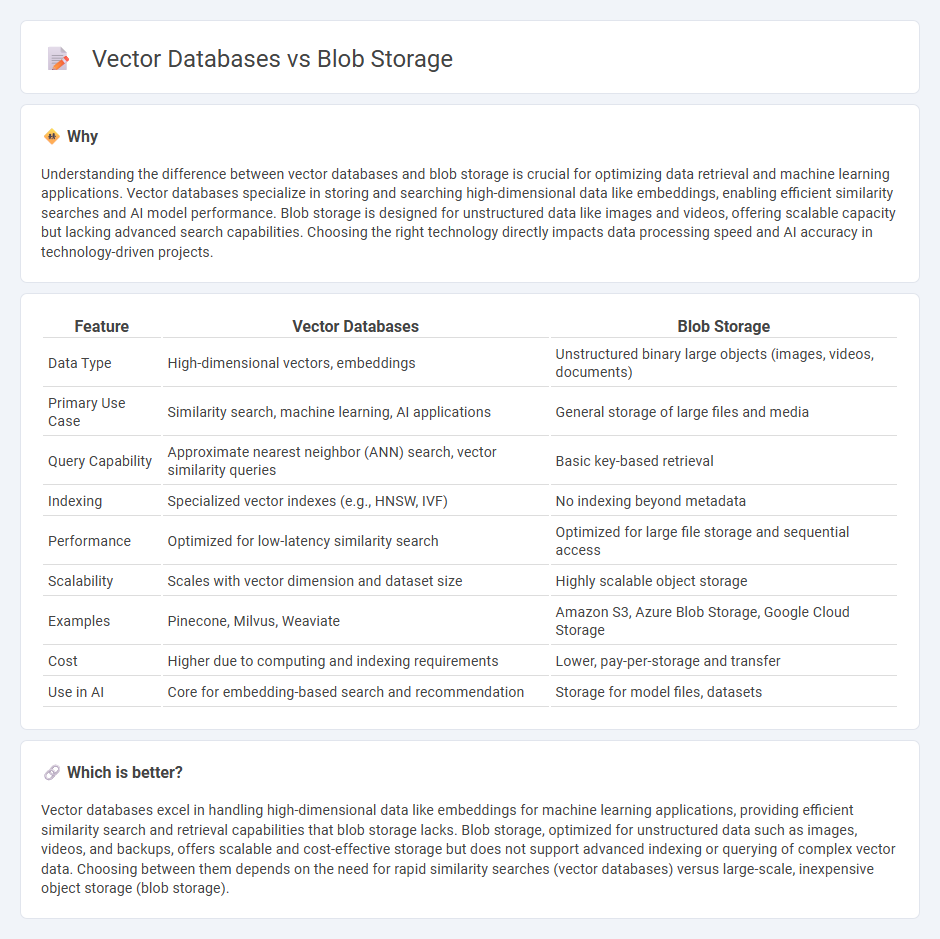
Vector databases efficiently handle high-dimensional data for machine learning and AI applications, enabling rapid similarity searches and complex data retrieval. Blob storage excels in managing unstructured data like images, videos, and backups, offering scalable, cost-effective storage solutions with easy access. Explore the key differences and use cases to optimize your data management strategy.
Why it is important
Understanding the difference between vector databases and blob storage is crucial for optimizing data retrieval and machine learning applications. Vector databases specialize in storing and searching high-dimensional data like embeddings, enabling efficient similarity searches and AI model performance. Blob storage is designed for unstructured data like images and videos, offering scalable capacity but lacking advanced search capabilities. Choosing the right technology directly impacts data processing speed and AI accuracy in technology-driven projects.
Comparison Table
| Feature | Vector Databases | Blob Storage |
|---|---|---|
| Data Type | High-dimensional vectors, embeddings | Unstructured binary large objects (images, videos, documents) |
| Primary Use Case | Similarity search, machine learning, AI applications | General storage of large files and media |
| Query Capability | Approximate nearest neighbor (ANN) search, vector similarity queries | Basic key-based retrieval |
| Indexing | Specialized vector indexes (e.g., HNSW, IVF) | No indexing beyond metadata |
| Performance | Optimized for low-latency similarity search | Optimized for large file storage and sequential access |
| Scalability | Scales with vector dimension and dataset size | Highly scalable object storage |
| Examples | Pinecone, Milvus, Weaviate | Amazon S3, Azure Blob Storage, Google Cloud Storage |
| Cost | Higher due to computing and indexing requirements | Lower, pay-per-storage and transfer |
| Use in AI | Core for embedding-based search and recommendation | Storage for model files, datasets |
Which is better?
Vector databases excel in handling high-dimensional data like embeddings for machine learning applications, providing efficient similarity search and retrieval capabilities that blob storage lacks. Blob storage, optimized for unstructured data such as images, videos, and backups, offers scalable and cost-effective storage but does not support advanced indexing or querying of complex vector data. Choosing between them depends on the need for rapid similarity searches (vector databases) versus large-scale, inexpensive object storage (blob storage).
Connection
Vector databases store high-dimensional vector embeddings representing complex data like images or text, enabling similarity search and machine learning applications. Blob storage provides scalable, cost-effective storage for unstructured data, including the raw files linked to these vectors. Together, blob storage houses the original data while vector databases index their vectorized representations for efficient retrieval and analysis.
Key Terms
Unstructured Data
Blob storage excels at storing vast amounts of unstructured data such as images, videos, and documents in their raw format, providing scalable and cost-effective storage solutions. Vector databases, on the other hand, specialize in managing unstructured data by encoding it into vector representations, enabling efficient similarity searches and AI-driven retrieval tasks. Explore how leveraging both technologies can optimize unstructured data management for advanced analytics and machine learning applications.
Embeddings
Blob storage efficiently manages vast unstructured data, including raw embeddings, but lacks inherent capabilities for similarity search or semantic querying essential for embedding-based applications. Vector databases specialize in storing and indexing high-dimensional embeddings, enabling rapid nearest neighbor search and advanced semantic operations critical for tasks like recommendation systems and natural language processing. Explore the advantages of vector databases in embedding management to enhance your AI and data retrieval projects.
Retrieval
Blob storage excels in storing unstructured data like images, videos, and backups with high scalability but offers limited retrieval capabilities based on metadata or file attributes. Vector databases are designed for efficient similarity search through numerical vector representations, enabling fast retrieval of semantically related content in applications like AI and recommendation systems. Explore the differences in retrieval performance and use cases between blob storage and vector databases to determine the best fit for your data needs.
Source and External Links
Introduction to Azure Blob Storage - Learn Microsoft - Azure Blob Storage is Microsoft's cloud object storage optimized for storing massive amounts of unstructured data like text or binary, supporting use cases such as media streaming, backup, and big data analytics with access via APIs and multiple protocols including HTTP/HTTPS, SFTP, and NFS.
What is blob storage? | Cloudflare - Blob storage is a highly scalable cloud-based object storage designed for storing unstructured data such as media files, backups, and logs, organizing data in flat containers called data lakes without a hierarchical file structure.
What Is Blob Storage? | Baeldung on Computer Science - Blob storage stores large volumes of unstructured binary data, often called binary large objects, in a flat storage system known as a data lake, making it flexible and scalable compared to traditional file or block storage methods.
 dowidth.com
dowidth.com